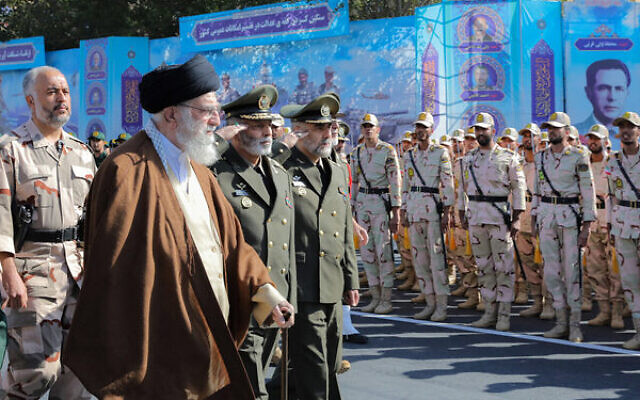The Iranian role in the unfolding events in the Middle East
'It is a widely accepted fact that Hamas could have not built its military capabilities without active and continuous Iranian support'

Shortly after the brutal attack Hamas carried out against Israel last Saturday, the issue of the Iranian role in the events became part of a wider discourse. On Wednesday, US President Joe Biden was quoted: “We made it clear to the Iranians: Be careful.”
There is little doubt among security and terror professionals that the unprecedented Hamas attack has Iranian fingerprints all over it. It is a widely accepted fact that Hamas could have not built its military capabilities without active and continuous Iranian support in arms, funds and military training. The specific modus operandi used during the attack mimicked plans that Hezbollah has been openly practicing for years. Another well-known fact is that Hamas operatives are being trained in Hezbollah facilities in Lebanon and on Iranian soil for years.
There is no need to have access to sensitive information to understand that transfer of military knowledge and planning took place between the sides.
Since the arrival of Salah Al Arouri, one of Hamas top Military leaders, to Beirut in 2018, the military cooperation between Hamas and Hezbollah has boasted. Both organisations also presented a united public front and enjoyed substantial support by the Iranian IRGC Quds force officers stationed in Lebanon.
No one should expect an open-source smoking gun that will point towards the Iranian involvement in the attack. This kind of military cooperation and joint decision-making processes are the realm of highly sensitive intelligence, which cannot be shared with the public.
The common interest of Hamas and Iran to downplay the Iranian part is clear: Hamas wants to brag and gain the internal Palestinian prestige of its “achievement”, while Iran is seeking the safety of deniability to avoid paying any prices for supporting terror acts.
In some respects, this behaviour was already seen in 2019, after Iran directly attacked Saudi oil infrastructures, never claiming responsibility for the act, nor paying a price for it. At the time, it was Tehran’s Houthi proxy forces in Yemen, who assumed false responsibility and helped Iran avert any international repercussions of its actions.
Iran, through its IRGC forces spread in Middle East, is an expert in cooperating with different local terror and insurgency groups, using the common interest of anti-western sentiments to build a net of proxy forces equipped and often funded and trained by Iran.
These proxies seldom operate under direct Iranian command. Most of the time, common interests and a wider strategical understanding are enough to integrate Iranian influence in the Middle East without direct military involvement of Tehran. It is the self-motivation of those different proxies to use terror to weaken Iranian rivals’ national security, which promotes Tehran’s goals.
Hamas, as the leading Palestinian terror group, is a classic example of this. Hamas is by no means an Iranian puppet, and it has its own interests and set of priorities. But in the last few months both Iran and Hamas had a critical need to create a military escalation because of Israeli-Saudi-American peace talks.
This deal is a joint strategic catastrophe. A scenario of a stronger Palestinian Authority (PA) in the West Bank, which enjoys massive economic support from Saudi Arabia and would offer new hope for a political solution to the Israeli-Palestinian conflict, is directly against Hamas’s interests.
At the same time, from the Iranian perspective, the potential of an American official long-standing commitment to the security of Saudi Arabia, which was a main factor of the deal, is a major strategic setback that would protect Riyadh from future Iranian attacks.
This common goal in the prevention of the Israeli-American-Saudi peace agreement, was a strategic “green light” from Iran to Hamas to carry out an unequivocal terror act that will derail the ongoing peace negotiations. The specific timing of October 7 was probably a tactical decision by Hamas, which knows best the arena and used it to its advantage for the maximal psychological impact.
By now, Hezbollah and Palestinian terrorists in Lebanon have already started tactical military engagement, forcing the IDF to reinforce its presence along Israel northern border. Israel and the Biden administration are investing great efforts to prevent the situation along the Lebanese border from further escalation, as such a scenario can lead to a full-scale war.
It is a prevailing fact that Hezbollah is operating freely in Lebanon, as the government in Beirut has no control over its territory. The Lebanese armed forces are too weak to confront it, and so are the UNIFIL forces stationed in southern Lebanon.
Hezbollah and its Iranian patrons are exploiting a very dangerous situation while ignoring loud and clear warnings from Israel and the US. Those actions of Hezbollah and the Palestinian terrorists in Lebanon, are undoubtedly coordinated with Iran, and hold the potential to rapidly escalate to a regional war which will destabilise the Middle East, with far reaching global implications.
Dror Doron is a senior political analyst specialising in the Middle East, who has worked for the last 17 years for the Israeli government as a research and analysis expert. He lives in Australia.

comments